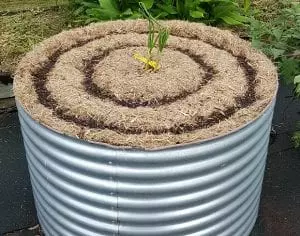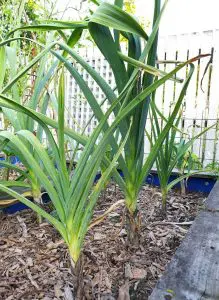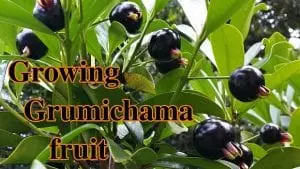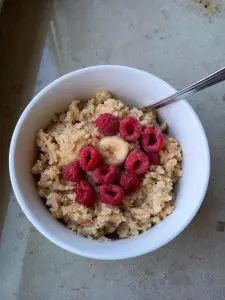Introduction
Cauliflower belongs to the brassica (botanical) family, which happens to be the largest vegetable family in the world and includes other vegetables like broccoli, cabbage, and even bok choy.
I sometimes think about the origins of vegetables (I'm a Pisces) and wonder who was the first person to find and try this vegetable? I'm sure the cauliflower he or she found in the wild Asian bush lands over 2000 years ago looked nothing like the vegetable we know today, but thanks to whoever that was who found the original we have cauliflower today.
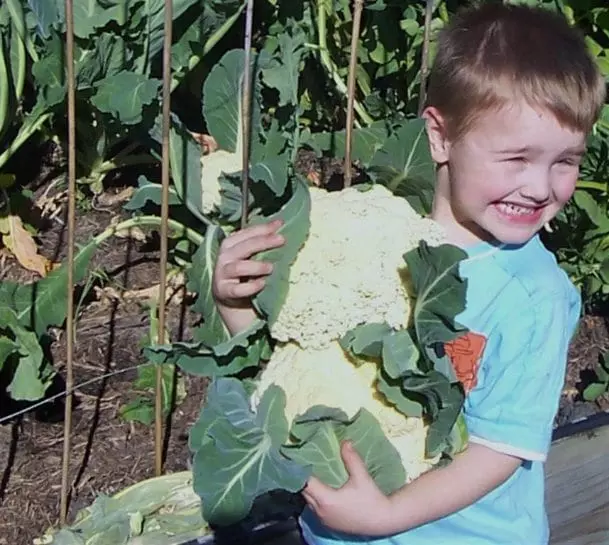
Cauliflower harvest for the backyard (above)
Diversity like so many other vegetables is cauliflowers middle name with varieties for different seasons, different sizes (mini – large), and different colours from a white curd, to creamy, and purple heads.
It's an odd looking vegetable and it reminds me, slightly, of an atomic bombs mushroom cloud with ripples of dense smoke throughout the head.
 Why grow cauliflower?
Why grow cauliflower?
Simply put, home grown cauliflower is better than the shops because it's fresher, and you know what chemicals are not on it.
Cauliflower can be baked, stir-fried, steamed, boiled, made into soup, sauces, and eaten raw.
Plus, cauliflower keeps pretty well in the crisper, can easily be pickled, and after a quick blanch it freezes nicely to store for that quick meal. You can also dry cauliflower (blanching first is recommended) by setting your dehydrator to the “live foods” setting. Cauliflower dried like this stores exceptionally well saving that valuable freezer space for something else.
Where can cauliflower be grown?
Planting cauliflower in an open sunny spot will ensure it gets the sun required to convert all the energy into a beautiful big floret. Part shaded areas will work; although, results are usually poor with smaller heads and leggy growth.
Cauliflower can be grown in almost any geographical location at the right time of year with the correct growing conditions.
When should cauliflower be planted?
Generally, cauliflower does best if grown as a cool season vegetable particularly in warmer regions. Autumn and winter are the best time for most places to start growing this cool season vegetable. Although, it's true certain varieties of cauliflower can be best suited to different growing seasons like an autumn or summer variety. Nevertheless, I personally prefer not to grow any cauliflower (regardless of season variety) through the hottest parts of the year.
If you live in an extremely cold climate then growing cauliflower in spring or summer is the best option, obviously.
How to grow cauliflower?
I wouldn't say cauliflower is dead easy to grow as there can be some challenges to producing a good consistent crop. Performance can plateau if: seedlings are handled a little too rough, not enough water or nutrients are available, or pests are left unchecked causing irreversible damage.

Cauliflower (foreground) growing in raised sleeper bed (broadbean behind and peas to the right)
Soil – The soil needs to be free draining and enriched with compost and natural fertiliser lik e animal manure. My secret is the quail and chicken manure mix (right image) I use prior to planting as this manure is rich in nitrogen (more than other manures) and cauliflower just loves nitrogen. I dig-in about two shovel fulls of manure per square foot (or there about) but don't overdo the manure making the soil too heavy as this will hinder growth rather than benefit it. Manure should be seen throughout the soil not BE the soil.
e animal manure. My secret is the quail and chicken manure mix (right image) I use prior to planting as this manure is rich in nitrogen (more than other manures) and cauliflower just loves nitrogen. I dig-in about two shovel fulls of manure per square foot (or there about) but don't overdo the manure making the soil too heavy as this will hinder growth rather than benefit it. Manure should be seen throughout the soil not BE the soil.
Size and space – Regular cauliflower plants are quite large and 40-50cm between plants (also rows) is a good idea to allow room for unhindered development. You can sow seed directly or in trays. I like to sow direct in stations with 2-3 seeds per station (each at 40-50cm apart) then thin-out to one strongest seedling when they are a few inches high and looking healthy.
There's usually several dozen seeds per packet but if you buy seedlings then your plants will already be a step ahead. Farmers markets are good places to buy seedlings from, ours sell seedlings at 10 for 1$ wrapped in wet newspaper rather than in the plastic punnet to save costs. It's not a bad savings for 10 plants compared with buying the full head in the store.
Post planting/sowing – After a few weeks of growth, I give the cauliflower plants a drink of seaweed solution (the recommended dose) and follow with another seaweed drink every 2-3 weeks. I don't add anymore fertiliser throughout the season because if the soil preparation at the start was good then there should be enough food in the soil to give the cauliflower all the nutrients in needs.
When the plants reach maturity in about 10-12 weeks the inner leaves curl slightly inwards (not for all varieties) and the curd starts to form.
 Harvesting – The heads develop surprisingly fast so once they start, don't make the mistake of leaving the plants to grow unattended thinking the heads will take a long time to develop because before you know it the heads will be full and then starting to spread for the flowering stage. (developing cauliflower curd left image)
Harvesting – The heads develop surprisingly fast so once they start, don't make the mistake of leaving the plants to grow unattended thinking the heads will take a long time to develop because before you know it the heads will be full and then starting to spread for the flowering stage. (developing cauliflower curd left image)
Tight heads is what we're after when growing cauliflower so timing is important for harvesting and removing the flower just on maturity before the opening stage (about a 7 day window) is the best practice. If the head does start to open slightly, it can still be eaten and the taste doesn't really differ too much. Just the same – harvesting the cauliflower should be done before any signs of opening.
Make a cut with some secateurs or a sharp knife at the base of the curd for removal. If the plant is left to grow-on, one or more significantly smaller curds may develop for a second harvest.
Seed collection – If you want to keep the seed just let a plant grow-on and flower; however, be aware of cross pollination risk with other brassica crops in the area. For certain vegetables, it's sometimes best to let the professional seed savers do this job and cauliflower (for me) tends to be one of those crops I buy the seed for.
 Dealing with a glut – Hopefully, not all the plants will mature at exactly the same time. Nevertheless, gluts can happen with several curds requiring harvesting at the same time. If this is the case, then either eat a lot of cauliflower FAST or preserve it like freezing.
Dealing with a glut – Hopefully, not all the plants will mature at exactly the same time. Nevertheless, gluts can happen with several curds requiring harvesting at the same time. If this is the case, then either eat a lot of cauliflower FAST or preserve it like freezing.
When freezing cauliflower, wash the curds and cut into small pieces before blanching them in boiling water for 2 minutes. Remove from the boiling water and place them immediately into a cold water bath (preferably ice-cube cold) to stop the cooking process. To ensure the cauliflower pieces don't freeze together in one big ugly clump, place the cauliflower pieces individually on a tray or on some wax paper and freeze. Once frozen, package up together in zip lock freezer bags.
Pests and diseases
Starting the plant in spring and summer can be a problem in warmer regions and not just a problem due to weather either but also insects. Insects that attack cauliflower are prevalent during the warmer months and cabbage white butterflies, aphids, whitefly, and slugs can really do great damage to crops with control methods (organic or chemical) virtually useless. 
These pests don't necessarily all go away through the cooler months though; therefore, checking the plants regularly for any signs of activity is important. Holes in the leaves, webbing, and a general unwell looking plant can be a sign of pests. Check closely and even check the curd as caterpillars and slugs will invade and nibble at the curd making a mess from the inside out.
Organic ways of controlling pests are things like: growing cauliflower at the right time of year for your climate, picking the pests off by hand, and companion planting (like marigolds or ornamentals, which harbour predator bugs).
Low toxic chemical control can also be used effectively. Pyrethrum spray and vegetable dusts are common low toxic ways to control pest outbreaks. Still, it's better to use nothing if possible and if chemicals must be used then consider bees and other good insects – perhaps spraying in the late afternoon will limit damage to the good guys.
Rot problems like clubroot, a fungi which attacks the root system of the plant, tend to be worse in summer also. The best defence to guard against soil born fungi and diseases is crop rotation. Once cauliflower has been grown in a bed try not to grow cauliflower (or other brassica) in that spot for a few years. Also, transplanting established seedlings into the garden bed instead of direct sowing may help avoid soil problems.
Conclusion
Growing cauliflower may not be the easiest vegetable to master but when the challenge is accepted and you see the resulting massive cloud-like heads emerging from those big green nest of leaves, you will be glowing with satisfaction.

A vegetable, with foundation origins in Asia over 2000 years ago, can continue it's successful survival story by growing-on in our gardens today. If you think about it deeply enough, it's like growing an antique and being part of history.
All drama aside, grow your own cauliflower just because you can.
Feel free to use the comment section below and have your say (no email is required).
Thanks for reading and thanks for your support.
Look, and see the Earth through her eyes
Mark Valencia – Editor SSM


